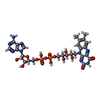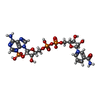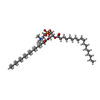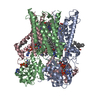+Search query
-Structure paper
| Title | Mechanism of stepwise electron transfer in six-transmembrane epithelial antigen of the prostate (STEAP) 1 and 2. |
|---|---|
| Journal, issue, pages | Elife, Vol. 12, Year 2023 |
| Publish date | Nov 20, 2023 |
 Authors Authors | Kehan Chen / Lie Wang / Jiemin Shen / Ah-Lim Tsai / Ming Zhou / Gang Wu /  |
| PubMed Abstract | Six transmembrane epithelial antigen of the prostate (STEAP) 1-4 are membrane-embedded hemoproteins that chelate a heme prosthetic group in a transmembrane domain (TMD). STEAP2-4, but not STEAP1, ...Six transmembrane epithelial antigen of the prostate (STEAP) 1-4 are membrane-embedded hemoproteins that chelate a heme prosthetic group in a transmembrane domain (TMD). STEAP2-4, but not STEAP1, have an intracellular oxidoreductase domain (OxRD) and can mediate cross-membrane electron transfer from NADPH via FAD and heme. However, it is unknown whether STEAP1 can establish a physiologically relevant electron transfer chain. Here, we show that STEAP1 can be reduced by reduced FAD or soluble cytochrome reductase that serves as a surrogate OxRD, providing the first evidence that STEAP1 can support a cross-membrane electron transfer chain. It is not clear whether FAD, which relays electrons from NADPH in OxRD to heme in TMD, remains constantly bound to the STEAPs. We found that FAD reduced by STEAP2 can be utilized by STEAP1, suggesting that FAD is diffusible rather than staying bound to STEAP2. We determined the structure of human STEAP2 in complex with NADP and FAD to an overall resolution of 3.2 Å by cryo-electron microscopy and found that the two cofactors bind STEAP2 similarly as in STEAP4, suggesting that a diffusible FAD is a general feature of the electron transfer mechanism in the STEAPs. We also demonstrated that STEAP2 reduces ferric nitrilotriacetic acid (Fe-NTA) significantly slower than STEAP1 and proposed that the slower reduction is due to the poor Fe-NTA binding to the highly flexible extracellular region in STEAP2. These results establish a solid foundation for understanding the function and mechanisms of the STEAPs. |
 External links External links |  Elife / Elife /  PubMed:37983176 / PubMed:37983176 /  PubMed Central PubMed Central |
| Methods | EM (single particle) |
| Resolution | 3.2 Å |
| Structure data | EMDB-25775, PDB-7tai: |
| Chemicals |  ChemComp-FAD:  ChemComp-HEM:  ChemComp-NAP:  ChemComp-LBN:  ChemComp-CLR: |
| Source |
|
 Keywords Keywords | OXIDOREDUCTASE / membrane-embedded oxidoreductase / membrane protein |
 Movie
Movie Controller
Controller Structure viewers
Structure viewers About Yorodumi Papers
About Yorodumi Papers





 homo sapiens (human)
homo sapiens (human)